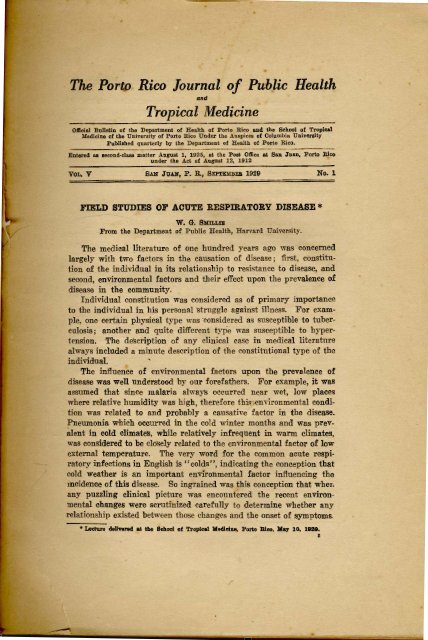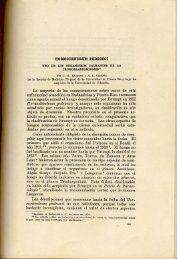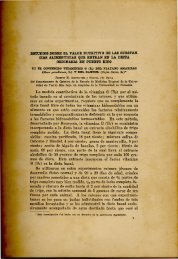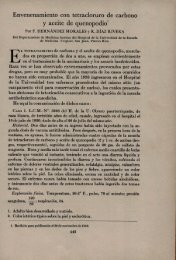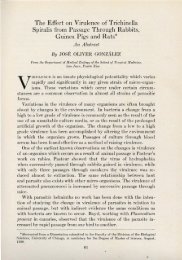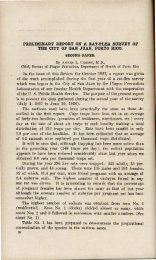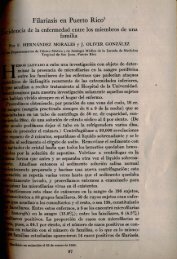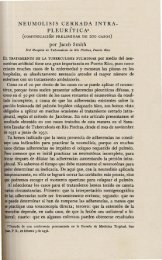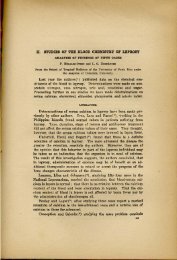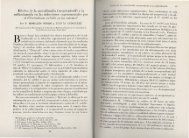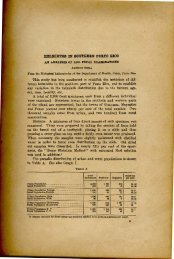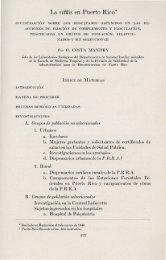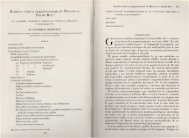Respiratory Disease.pdf
Respiratory Disease.pdf
Respiratory Disease.pdf
You also want an ePaper? Increase the reach of your titles
YUMPU automatically turns print PDFs into web optimized ePapers that Google loves.
The Porto Rico Journal of Public HealthandTropical MedicineOllle!al Bulletin of the Department of Health of P ort o Rico and the School of Tr op icalMedicin e of the Uni ...ersity of Porto Rico Under Ihe Auspices of Oolumbla UnlveraltyPublished quarterly by the Deportment of H~alth of Po rt o Rico .---VOL. V BAN JOAN, P. n., S EP'l'DIBEB 1929 No.1FIELD STUDIES OF ACUTE RESpm ATORY DISEASE *W. G. SMILLIEFrom the Department of Public Health, Harvard University.The medical literature of one hundred years ago was concernedlargely with two fa ctors in the causation of disease; first, eonstitutionof the individual in its relationship to resi. tanee to disease, andsecond, environmental factors and thei r effect upon the prevalence ofdisease in the community.Individual constitution was considered as of primary importanceto the individual in his personal 'struggle against illness. F or example,one certain physical type was 'considered as susceptible to tuberculosis;another and quite different type was susceptible to hypertension.The description of any clinical ease in medic al literaturealways included a minute description of the constitutional type of theindividual.The influence of environmental factors upon the prevalence ofdisease was well understood by our for efathers. For example, it wasassumed th at since malaria always occurred near wet, low placeswhere relative humidity was high, therefore this environmental conditionwas related to an d probably a causative factor in the disease.Pneumonia which occurred in the cold winter months and was prevalentin cold climate's, while r elatively infrequent in warm climates,was considered to be closely related to the environmental factor of lowexternal temperature. The very wor d for the Common acute respiratoryinfections in E nglish is "colds", indicating the conception thatcold weather is an important environmental factor influencing th eincidence of this disease. So ingrained was this conception that wher,any puzzling clinical picture was encountered the recent environmentalchanges were scrutinized carefully to determine whether anyrelation hip existed between those changes and the onset of symptoms.• Leetun deUvwed at tile School of Tropleal VedlalJle, Porto )Uco, )(&7 10. 18:18.3
4. PORT O RICO JOt ,."RN AL O ~' PUBLIC H EALT H AND TROP. ~rEDICINl!lWhen epidemics occurred, the study of environmental influences wasmuch more exhaustive. It has been noted for centuries that certainepidemic diseases occur in cyeles.c-smallpox, plague, cholera, influenzaand many others. In these epidemics careful observations were madeof environmental conditions both before, du ri ng, and after the epidemic,including temperature. hours of sunshine, direction and velocityof the wind, r ainfall, phases of the moon, the tides, currents,tbe seasons, planetary conjunctions, ctc. One of the most exhaustiveof th ese stu dies was that of NOaJl Webster, best kn own as author of"\Yebster 's dictionary.Then came th e studies of Pasteur and his discovery of actualcausal agents of disease. Ho w medical literature changed its characterand how th ings were simplified , for it seemed clear that forevery disease there was some specific causal agent. In ra pid successionth e etiological agent" were discovered for tuberculosis, plague,leprosy, typhoid fever, diphtheria, cholera , malaria, dysentery, pneumoniaand many oth ers.It was assumed first that each disease had its specific etiologicalagent. and when that disease existed the organism would be foundpresent. Second, it was assumed that where the agent existed, thereone found the disea e. It was soon found, however, tha t though formanv diseases the first premise held, the second did not. In manyinstances th e specific organ isms of a disease were found in perfectlynormal indiv id uals. Gradually there was built up the science of immunology,the resisten ee of the individual to etiological agents ofdisease, and laws of na tural and acquired immunity were determined.Gradually there has been a return 10 the ideas of our forefathers inrelation to one of their fundamental conceptions of disease; namely,the inherent constitution of the individual in his natural resista nce todisease.More recently we }J8Ve begun to realize that neither the discoveryof etiological agents nor the diseoverv of laws of immunity were sufficientto explain cert ain phenomena. par-ticularly in epidemics ofdisease.For example, if the degree of immunity of individuals in a community to typhoid fever is a con tant and the prevalence of typhoidbacilli carriers 'in the community is also a constant , why is therealwavs a rise in the typhoid fever incidence in the communitv at certainseasons of th e yea r' Why does diphtheria occur each' year atOb011t th e same period. reach its maximum at the same period anddecline always in the same manned It is obvious that if th is phenomenoeof '!Ipasonsl prevalence of disease if; solved, it may give lUI
FIELD STUDIES OF ACUTE RESPIRATORY DISEASEimportant information concerning the whole mechanism of diseaseproduction an d perhaps aid us in disease prevention.What are th e factors which enter into seasonal variation? Clearlythey are changes in ext ernal envi ronmental factors, such as temperature,hour's of sunlight, barometric pre sure, wind velocity, rainfall,relative humidity, etc. Here, in truth, we have returned to thesecond conception of our fore fathers, namely, the importance ofenvironmental factors upon the prevalence of disease both in theindividual and th e community. One very r ecent and exha ustivestudy of the inlluenee of ell rironment. upon disease is that of Rentschler, Vanzant and Roundtree, who have studied the question ofarthritic pain in relation to weather change's, and in which they haveshown clearly a correlation between the degree of arthritic pain andchanges in barometric pressure .Aycock has made a careful , tudy of the significance of geographiclind seasonal variations in the incidence of poliomyelitis. He suggeststhat there are t wo type's of resistance to disease, first, immunitywhich is built up as a result of invasion of the body by the etiologicalagent of disea se, and second, the power of resistance which exists byreason of a balanced physiological activity and which he calls"autareesis". It is suggested t hat variation in physiological balance of thebody due to environmental influences may explain variation in resitance to poliomyelitis and thus seasonal prevalence of the disease.One group of disease: that is closely associated with changes inenvironment is the group of acute infection's of the respiratory tract.The causal agent and the.epidemiology of some of these infectionsare qui te well understood ; for example, diphtheria, scarlet fever,tonsilitis, pneumonia, etc. We are quite at sea, however, in regardto the etiology of the most common of all acute respiratory infections,-namely,common colds, grippe, and influenza. The clinicalpicture of this group of diseases is not clear cut, and differentialdiagnosis is rather an arbitrarv one. These diseases have beenstudied exhaustivel y fro m the bacte riological standpoint. The bacteriologistsare divided roug hly into two groups, those who believe thatinfluenza is caused by the bacillus of P feiffer and those who believeit is caused by one of the group of filter-passing organisms describedby Olitsky mid Gates. A grea t variety of organisms have been consideredas causal agent: of colds. Bacteriological findings have beenconflicting and quite confu ring. The bacillus of Pfeiffer i'S foundfrequently in other conditions than influenza, is not always found inty pical epidemic influenza and, when found, is often most prevalentin the nasopharynx of influ enza cases late in the course of the disease.
6 PORTO RICO JOURNAL OF PUBLiC HEALTH AND TROP. MEDICINE'I'he pneumosintes group of organisms consists of a large group ofquite similar, filterpnssiug, ram negative, tiny anerobie forms,which ha ve not always been found in epidemics of influenza andwhich have not produced influenza when inoculated into th e nasopharynxof presumably susceptible individuals.It is obvious that unless we can determine the etiological agentof this group of acute respiratory iuleetious, or at least to dete rmineclear-cut procedures for differential diagnosis of the group, we cannotsucceed in developing methods of prevention or control of thisgroup of very common infections,\ 'e may be dealing with an etiological agent that has not yet beendiscovered; on the other hand, the etiological agent may be one ofthe many types of orga nism found norm ally in the nasopharynx andwith which we are familiar. Infection may occur because of changesin virulence of the organism, or changes in the physiological balanceof the individual producing an " anautarcesis " , which permits invasionof the tissue by an organism which under normal conditionswould be avirulent. In either ease, we must assume that environmentalfactors play the deciding part in influencing the change ofeither increased virulence of the organism or decreased resistance oft he individual.One method of attacking this problem is to undertake a studyof the normal flora of the nasopharynx and to follow the changeswhich occur in the individual and in the environment when thesepersons already studied develop an upper r espiratory infection.Such studies have been made by J ordan, Park, Doehaz, Noble andtheir eo-workers, All this work has been done in densely populatedcenters where the persons studied are in direct conta ct with a largenum ber of other persons and subjected to a great variety of environmentalfactors which may affect the respiratory flora, In an attemptto mini mize these extraneous factors we have undertaken a fieldstudy of acute respiratory disease in isolated communities where lifeis simple, contacts relatively infrequent, and envir onmental factorsmore readily estimated and controlled.This field unit consists of a portable laborat ory with a small personnelof epidemiologist, bacteriologist, and technician. Supplementarynon-technical personnel are secured at each post. The firstare a selected for study was" Happy Hollow", Alaba ma, an isolatedsection along the Patsiliga River near the Gulf of Mexico. Here asmall group of normal people were studied over a period of foul'months. During the study an epidemic of acute respiratory diseaseoccurred which was followed throughout its cours e, In May, 1928,
,.FIELD STUDIES OF CUTE RESPIRATORY DI~•the field unit went to •Iorthwest River, Labrador, a Hudson BayCompany fur trading post in th e interior of Labrador. A group offur trappers were studied for three months. At the same time, atribe of nomadic Indians from the highlands of Lab rador came outto the post to trade, and studies were made of this group. Duringthe period of study an epidcmie of acute respiratory disease oeeurrsdwhich was followed th rough its COUl' "e. In March, 1929, thefield unit 'Went to Porto Rico, and using thc School of Tropical Medicineas a base of operations, e rtablished a field laboratory in St.J ohn 's, one of the 'small Virgin Islands, where field work is beingcontinued. In each field post serial cultures are made of the bacterialflora of the nasop harynx of a group of selected individuals. Inaddition, records are kept of baromet ric pressure, rainfall, dailymaximum and minimum temperature, relative humidity, etc. I t isnot anticipated that any startling discoveries will result from thesestudies, but it is hoped that a slow and painstaking compilation ofdata over a period of tim e under widely varying conditions may offersome suggestions which may aid u · in our solut ion of the etiologicalagent, the epidemiology and possibly method of prevention of acuterespiratory disease.BIBLIOGRAPHYAycock, W. L.: (1929) Jour. Prevo l'vIed., 3: 245.Rentschler, E. B., Vanzant. F. R. and Roundtree, L. G. : (1929)Jour. Am. !.led. Ass'n, ~: 1995.


